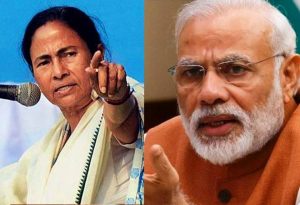 By Nageshwar Patnaik in Bhubaneswar, May 1, 2021: The Mamata-Modi faceoff has finally come to an end at least for the time being with the conclusion of battle of ballots for the West Bengal Assembly. The poll outcome on May 2 is pretty crucial for the Bharatiya Janata Party’s plans to win over the east as it is the last frontier for the party to make the country saffron. On the contrary, if Mamata Banerjee retains power, it could pave the way for the revival of a battered Opposition.
By Nageshwar Patnaik in Bhubaneswar, May 1, 2021: The Mamata-Modi faceoff has finally come to an end at least for the time being with the conclusion of battle of ballots for the West Bengal Assembly. The poll outcome on May 2 is pretty crucial for the Bharatiya Janata Party’s plans to win over the east as it is the last frontier for the party to make the country saffron. On the contrary, if Mamata Banerjee retains power, it could pave the way for the revival of a battered Opposition.
Exit polls predict close Bengal fight with thin edge for Mamata. But the saffron party claims to dislodge Mamata’s Trinamul Congress and form the first government in Bengal in the backdrop of its landslide victory in the 2019 Lok Sabha elections. From only two seats in the 2014 Lok Sabha elections, the BJP had increased its tally to 18 in 2019. Equally impressive was the sharp rise in its vote share from 16.8% in 2014 to 40.25% in 2019.Will it be able to dethrone Mamata and ensure a puzzling and phenomenal win in West Bengal?
In most states and Bengal in particular, the Centre is always looked as an aggressor and the state a victim. This has resulted in consolidation of Bengali regional identity and victory by Hindu nationalist BJP will deconstruct that social and political ethos built around Bengali asmita (pride). Mamata is known for her impassioned love for Bengal, her unequivocal emotional bonding with Bangla language and culture. Her party’s slogan – Ma, Maati, Maanush – was born out of this bond.
It is the regional forces which are now mostly standing up to the BJP’s might as the regional aspiration and identity has turned out to be the biggest challenger to a pan-Hindu India. Mamata has turned BJP’s usual identity politics upside down. Responding to BJP’s Hindu versus Muslim narrative, she has made it into a Bengalis versus outsiders issue, a question of Bengali ‘asmita’ as opposed to Gujarati ‘asmita’ that Modi has successfully played upon in his home state.
Mamata has been pointing out how Nobel Laureate Amartya Sen has been humiliated and ridiculed by the Modi Government and the BJP. While BJP gloats at Trinamool defectors deserting the sinking ship, Mamata called them traitors and painted Amit Shah as the unscrupulous broker. More so, she invoked sub-Bengali nationalism by rallying women and minorities to her side. Pointing out that record of her party’s governance in Bengal has been better than Modi’s, she has blunted the edge of the attack on her government. Reeling out the central government’s own statistics, she has been able to convey how Bengal has performed better than Gujarat on several development indices.
 Mamata has also been successful in getting support from regional parties from Bihar, Uttar Pradesh and Maharashtra to Trinamool Congress in her fight against BJP, which has emerged as the main challenger to TMC in Bengal for the first time. No doubt, the assembly election in West Bengal is turning into a Mamata versus Modi battle. It could pave the way for Mamata straight into the national canvas if she wins her third term in office. A TMC victory in Bengal could change alliance equations, with Mamata emerging on the centre stage of national politics with an eye on the 2024 Lok Sabha polls.
Mamata has also been successful in getting support from regional parties from Bihar, Uttar Pradesh and Maharashtra to Trinamool Congress in her fight against BJP, which has emerged as the main challenger to TMC in Bengal for the first time. No doubt, the assembly election in West Bengal is turning into a Mamata versus Modi battle. It could pave the way for Mamata straight into the national canvas if she wins her third term in office. A TMC victory in Bengal could change alliance equations, with Mamata emerging on the centre stage of national politics with an eye on the 2024 Lok Sabha polls.
All through the electoral campaign, she raked up the outsider-insider politics and has frequently invoked Bengali pride and roped in poll strategist Prashant Kishor to plot her strategy. Regional pride is the new political plank and Mamata all through the campaign has started harping on “Bengali pride” to contain the BJP surge, while the BJP had assiduously pursued to cultivate Hindu votes in the State.
Will regional pride be an effective counter to the rising tide of religious nationalism in the state? Or will it deepen the existing polarisation at the twin poles of religion and regionalism? Beyond the ideology, the fall of Mamata Banerjee, a regional satrap, will add a momentum to the BJP-led central government’s push towards a more centralised system of governance as against cooperative federalism. The incumbent TMC government in West Bengal is most vocal against the contentious agenda of the Modi government such as implementing the Citizenship Amendment Act (CAA), reforms in power and agriculture sector and labour laws.
The non-BJP governments’ fight against the Centre will definitely be weakened in the absence of a dogged Mamata Banerjee at the helm in West Bengal. On the other hand a defeat of the BJP in West Bengal will give much needed ammunition to the opposition to mount a spirited assault on the Narendra Modi government.
The Modi government is now passing through its weakest phase ever with economy in doldrums; farmers up-in arms, petroleum prices causing deep holes in the pockets of aam aadmi and the COVID-19 pandemic raising its ugly fang once again killing hundreds in the country. At this crucial juncture, a defeat in Bengal would be the last thing the BJP leadership would want after putting so many stakes in this election.
Barring Assam, the BJP does not stand any chance of its own in Tamil Nadu, Kerala and Pondicherry. Only in Assam, the BJP’s prospects seem to be bright as it was projected before the commencement of election process. A defeat for the BJP in West Bengal may compel the party to take a hard-look on its strategy of communal polarization as an effective plank to win elections, particularly in states where a large chunk of voters are from minority communities.
Mamata’s victory may lead to a rise of regional parties to stem the BJP’s Juggernaut.



Leave a Reply
Be the First to Comment!